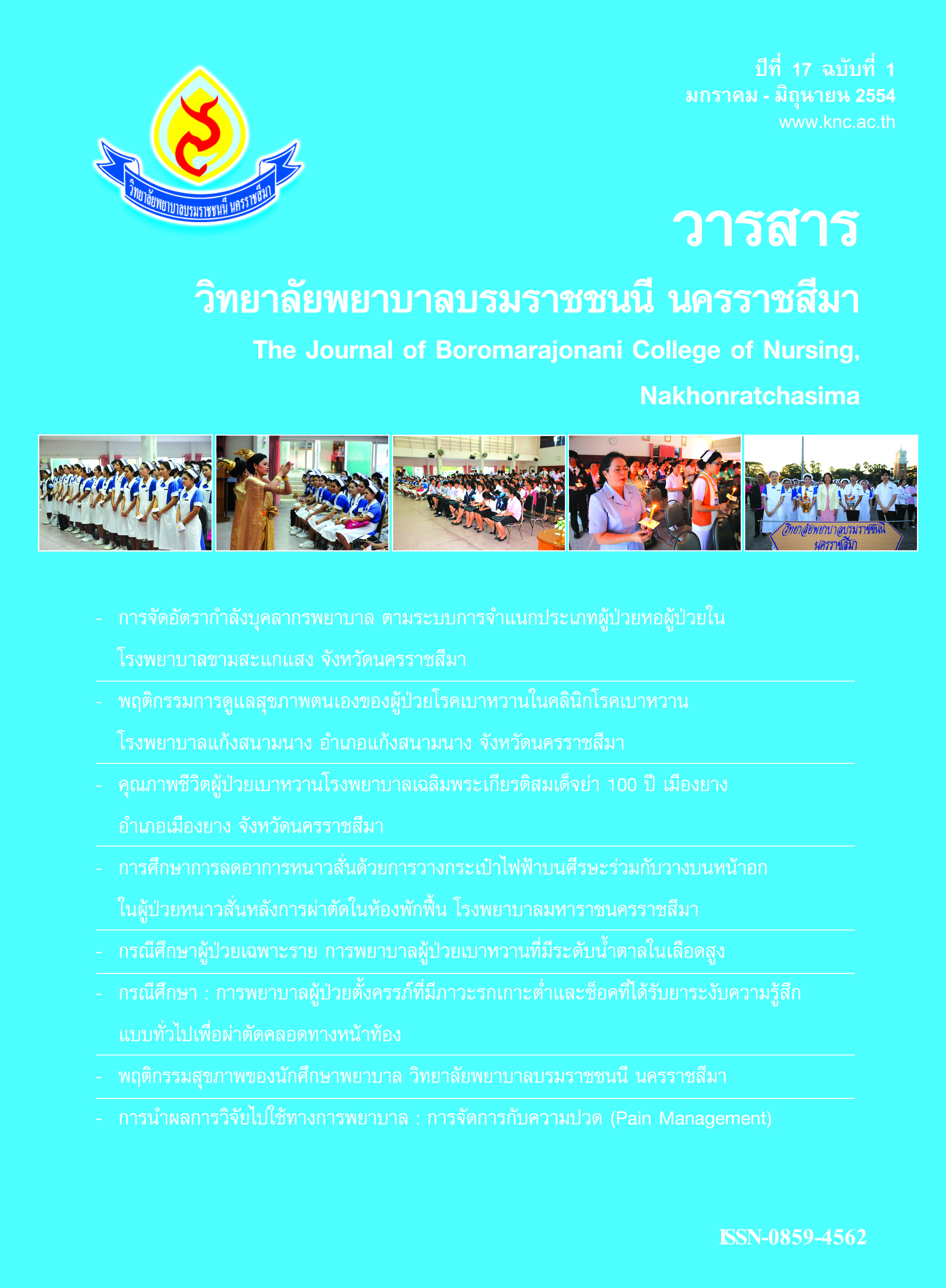การศึกษาการลดอาการหนาวสั่นด้วยการวางกระเป๋าไฟฟ้าบนศีรษะร่วมกับวางบนหน้าอก ในผู้ป่วยหนาวสั่นหลังการผ่าตัดในห้องพักฟื้น โรงพยาบาลมหาราชนครราชสีมา
คำสำคัญ:
กระเป๋าไฟฟ้า, หนาวสั่น, การผ่าตัด, heating pad, shivering, post operativeบทคัดย่อ
บทคัดย่อ
อาการหนาวสั่นหลังการผ่าตัดทำให้ร่างกายใช้ออกซิเจนมากขึ้นและ เพิ่มการทำงานของหัวใจ งานวิจัยครั้งนี้จึงมีวัตถุประสงค์เพื่อศึกษาเปรียบเทียบความแตกต่างของระยะเวลาการหายจากอาการหนาวสั่นระหว่างการวางกระเป๋าไฟฟ้าบนหน้าอกกับวางกระเป๋าไฟฟ้าบนหน้าอกร่วมกับการวางกระเป๋าไฟฟ้าคลุมบนศีรษะ ในผู้ป่วยหลังการผ่าตัดที่มีอาการหนาวสั่นขณะอยู่ในห้องพักฟื้น โรงพยาบาลมหาราชนครราชสีมา กลุ่มตัวอย่างเลือกแบบเฉพาะเจาะจงตามคุณสมบัติที่กำหนดจำนวน 40 รายและนำมาเป็นกลุ่มควบคุมจำนวน 20 คน และกลุ่มทดลอง จำนวน 20 คน เครื่องมือที่ใช้ประกอบด้วยแบบบันทึกข้อมูลส่วนบุคคล และเครื่องมือในการทดลองได้แก่ กระเป๋าไฟฟ้า นาฬิกาจับเวลาและผ้าห่ม วิธีการดำเนินการวิจัย กลุ่มควบคุมได้รับการห่มผ้าสองชั้นและวางกระเป๋าไฟฟ้าบนหน้าอก สำหรับกลุ่มทดลองได้รับการวางกระเป๋าไฟฟ้าคลุมบนศีรษะเพิ่ม ผู้ป่วยทั้งสองกลุ่มได้รับการดูแลในระยะพักฟื้นตามมาตรฐานการดูแลผู้ป่วยหลังการผ่าตัดในห้องพักฟื้น ผู้วิจัยจะบันทึกระยะเวลาที่ผู้ป่วยมีอาการหนาวสั่นจนถึงไม่มีอาการหนาวสั่น วิเคราะห์ข้อมูลโดยใช้ ร้อยละ ค่าเฉลี่ย ส่วนเบี่ยงเบนมาตรฐาน และสถิติทดสอบค่าที ผลการศึกษาพบว่า ค่าเฉลี่ยของระยะเวลาการหายจากอาการหนาวสั่นในกลุ่มการทดลองและกลุ่มควบคุม เท่ากับ 12.95 นาที และ 22.85 นาทีตามลำดับ และเปรียบเทียบความแตกต่างของระยะเวลาการหายจากอาการหนาวสั่น ทั้งสองกลุ่มพบว่ามีความแตกต่างกันอย่างเป็นนัยสำคัญทางสถิตที่ระดับ 0.05 แสดงว่าการใช้กระเป๋าไฟฟ้าวางบนหน้าอกร่วมกับวางคลุมบนศีรษะ ช่วยลดอาการหนาวสั่นหลังผ่าตัดและลดระยะเวลาในการดูแลผู้ป่วย ดังนั้นการดูแลผู้ป่วยที่มีอาการหนาวสั่นควรได้รับการวางกระเป๋าไฟฟ้าบนหน้าอกร่วมกับวางคลุมบนศีรษะทุกราย
คำสำคัญ : กระเป๋าไฟฟ้า, หนาวสั่น, การผ่าตัด
Abstract
Shivering in a post operation increases oxygen consumption and enhance cardiac function. The study's aim is to compare the difference in the time it takes to stop shivering using two treatments; the first treatment was to treat by using one heating pad and placing it on the patient’s chest, the other was to place the heating pad on the patients head and chest. The patients used had undergone an operation using a spinal block and were recovering at Maharat Nakhon Ratchasima Hospital. A random sample of 40 was chosen, dividing each member into a group at 2 groups of 20 subjects. There were 2 tools used in the process, the first being a questionnaire to ascertain personal data from the subject, the second being an experimental component using a heating pad, a stopwatch, and blankets. The method used was having the control group covered with 2 layers of blankets and the heating pad on the chest, the experimental group had two layers of blankets as well but also had the heating pad on their chest and their head. The two groups were treated as a standard patient in a post operative recovery room with the shivers and kept until they could be returned to the patient dormitory. The data collected about the amount of time the patient suffered from the shivers was analyzed by percentage, average, standard deviation and t-test. The results showed that, average time lost from the shivering in the experimental group and control group was 12.95 minutes and 22.85 minutes respectively. The difference of time lost from shivering in both groups found that the difference was statistically significant at the 0.05 level. The data shows that the use of a heating pad placed on the chest reduced the shivering after surgery and reduced the time of care for patients in the recovery room.
Keywords : heating pad, shivering, post operative
ดาวน์โหลด
ฉบับ
ประเภทบทความ
สัญญาอนุญาต
บทความที่ได้รับการตีพิมพ์เป็นลิขสิทธิ์ของ วารสารสุขภาพและการศึกษาพยาบาล ซึ่งดำเนินการโดยวิทยาลัยพยาบาลบรมราชชนนี นครราชสีมา
ข้อความที่ปรากฏในบทความในวารสารเล่มนี้เป็นความคิดเห็นส่วนตัวของผู้เขียนแต่ละท่านไม่เกี่ยวข้องกับกองบรรณาธิการวารสารสุขภาพและการศึกษาพยาบาล หรือวิทยาลัยพยาบาลบรมราชชนนี นครราชสีมา แต่อย่างใด ความรับผิดชอบองค์ประกอบทั้งหมดของบทความแต่ละเรื่องเป็นของผู้เขียนแต่ละท่าน หากมีความผิดพลาดใดๆ ผู้เขียนแต่ละท่านจะรับผิดชอบบทความของตนเองแต่ผู้เดียว







